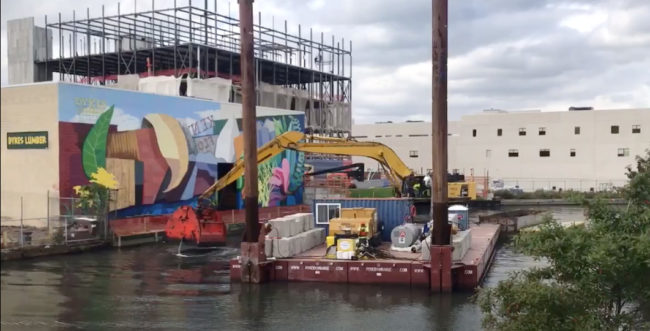On 10th anniversary of cleanup efforts, progress lags on Newtown Creek; more community voices are needed in Brooklyn and Queens.
New York City’s two most notoriously polluted waterways were listed as federal Superfund sites within months of each other a decade ago. Since then, a full-fledged cleanup has begun in Gowanus Canal – yet Newtown Creek has no relief in sight.
On the 10-year anniversary of their listing, the two waterways, situated just 5.5 miles away from each other in Brooklyn and Queens, could not be further apart in the pace of their remediation processes. Community voices are critical to keeping both efforts moving forward.

Cleanup begins in Gowanus Canal
The Gowanus Canal Community Advisory Group and elected officials cheered in November 2020 as contractors began dredging contaminants from the head of the canal. “Black mayonnaise,” a mixture of liquid tar from manufactured gas plants, petroleum products, raw sewage and other contaminants, coats the bed of the waterway. The U.S. Environmental Protection Agency has directed the parties most likely responsible for the contamination to “dredge and cap” the canal to protect human health and wildlife. While that process proceeds, EPA is also forcing New York City to construct two sewage capture tanks, as the raw sewage still being dumped into the canal by the city contains toxic contaminants, too.
That’s not to say there are no challenges ahead for Gowanus Canal:
- The cleanup will take years as planned, and it is still subject to legal maneuvering by the parties potentially responsible for contamination. In 2020, New York City requested extensions of its sewage capture tank construction, which would prolong the ongoing toxic sewage discharges. Although denied this time by EPA, the grumbling of the parties paying for the cleanup is not expected to cease anytime soon. We applaud the efforts of EPA staff to promptly usher the Gowanus cleanup through the Superfund process and to continue to hold polluters to account.
- Despite these efforts, pollution will continue. Long after the sewage tanks are constructed and the canal bed has been dredged, the canal will still receive roughly 110 million gallons per year of raw sewage and polluted stormwater discharges. Climate change and the proposed Gowanus rezoning could exacerbate those discharges.
Studies drag on in Newtown Creek
Meanwhile, the Newtown Creek cleanup has been delayed years, mired in discussions over the “Remedial Investigation/Feasibility Study.” Ongoing studies are expected to continue throughout 2022.

Newtown Creek is a larger waterbody than Gowanus Canal (3.8 miles to 1.8 miles), and its Greenpoint side is home to one of the largest North American oil spills – 50 percent larger than the Exxon Valdez disaster. Riverkeeper’s patrols and legal action catalyzed the cleanup of this area, where refining operations leaked oil and oil products into the soils and aquifers of Greenpoint over decades. Other manufacturing operations and ongoing sewage discharges have left thick layers of black mayonnaise and other contaminants.
As the remedial studies proceed, potentially responsible parties are taking advantage of the slow process and attempting to undermine the eventual remedy. They are doing so by devising “focused” studies that, if accepted by EPA, could allow for an overall lesser cleanup, ultimately failing to protect human health and the environment.
For instance, a group of industrial parties has proposed a superficial cleanup of the lower 2 miles of the creek. The proposal comes before the EPA could fully model the pollution or determine what threshold of pollutant removal is necessary to protect health. Similarly — and outrageously — New York City has proposed no additional reduction of its raw sewage discharges beyond what it has planned to complete by 2042. That plan would leave over half a billion gallons to be discharged annually, even when cleanup is complete. Again, advocates are concerned that, with modeling and cleanup thresholds still being investigated, the city’s “do nothing more” proposal should could potentially hinder the overall cleanup. This is unacceptable.
Newtown Creek needs your help to drive EPA action
Sadly, these two waterways could compete for the title “most polluted in the country.” Newtown Creek is twice as large and receives more raw sewage, but Gowanus Canal has some major hot spots of toxic pollution. Regardless, there can be no debate which site is currently in a better position for the future. Years of strong advocacy from the Gowanus Community Advisory Group and EPA staff have culminated in the Gowanus cleanup process moving forward, leaving Newtown Creek in the dust. Nevertheless, ongoing participation in the Gowanus Community Advisory Group is crucial to ensure the cleanup is completed and protected from the rezoning, new development and climate change.
EPA staff have unfortunately moved much slower to complete the studies of Newtown Creek. The delay lies wholly within control of the agency. To push EPA to move faster, local community members from both the Brooklyn and Queens sides are needed to join the Newtown Creek Community Advisory Group. The purpose of the group is to advise EPA about the cleanup and give voice to local needs. We must demand that the EPA move swiftly and direct the parties potentially responsible for the cleanup to devise a meaningful remediation plan for the whole creek that will fully protect human health and bring life and recreational opportunities back to the waterway. Please visit this page to learn more and submit a CAG membership application.
Learn more:
- Newtown Creek Alliance
- Newtown Creek Vision Plan
- Gowanus Canal Conservancy
- Gowanus Lowlands Master Plan
* * *
NOTE FROM GO GREEN BK: The next Newtown Creek Community Advisory Group (CAG) meeting is this Thursday, January 28, 2021 from 6:30 to 8:30 PM online. Find more info on Go Green BK’s calendar of events. You must register in advance.



